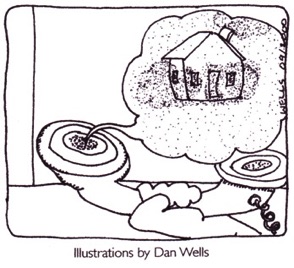That Mysterious Soot Might Be from Candles
One day you notice dark marks on your walls, ceilings or furnishings where you’ve never seen them before.
You may notice dark streaks on wall surfaces over framing studs or air conditioning supply vents. Perhaps the walls are darkened above baseboard heaters. Maybe you’ve found black particles on tables, countertops, or on your window blinds, computer, medicine cabinet or freezer!
What is that black stuff? Is it soot? Where could it be coming from? You call a chimney sweep!
Sources of soot in the home may include furnaces, fireplaces, and space heaters. Any fuel-burning appliance can be a source of soot when combustion is incomplete. To be sure these appliances are operating and venting correctly, get them checked out. A competent chimney sweep or venting service technician may be able to assist you in diagnosing problems and suggest appropriate solutions.
Other sources include cigarettes, incense, cooking, water heaters, and infiltration of automobile exhaust and polluted outdoor air. Candles are becoming a more frequent culprit.
Sooting from Candles
Reports of sooting in homes from candle use have been increasing in recent years. Candles are a $2.3 billion per year industry growing at 10-15% per year.
“Airborne soot particles caused from burning candles eventually collide with other particles,” says Dr. Jesse La Prade, an Alabama Cooperative Extension environmental specialist. “As particles grow in size from these airborne collisions, they are eventually forced by gravity to settle on tables, counters and other services throughout the home.”
“Due to the lack of air exchange, burning a single candle a week in a tight, well-insulated home can cause very worrisome wall darkening,” according to Jeffrey C. May, a professional home inspector in Cambridge, MA.
Soot is distributed by air currents in the home and is deposited in certain areas due to attractive forces including temperature, humidity and static charges.
Damage can be expensive. “Some homeowners have spent as much as $80,000 to clean and replace household furnishings that have been marred by candle soot,” says Ron Bailey, owner of Bailey Engineering Corp., a Palm Beach Gardens, FL, indoor air quality engineering firm. Heating and air conditioning systems can be damaged, too. Entire systems, including air ducts, may need to be replaced.
Extensive damage has been reported with just a few hours of candle burning.
Testing for Candle Soot
There is a simple test you can do if you suspect candles are causing a soot problem in your home, suggested by Cathy Flanders, moderator of the Indoor Air Quality Internet forum where candle sooting is a frequent topic.
You’ll need some medium or large Styrofoam drinking cups. The lip of the cup should be higher the wick of the candle. Don’t separate the cups until testing is ready to begin. Obtain several of the candles suspected of sooting. Go to a confined area such as a bathroom. It is very important to close or block all the heating and air conditioning (HVAC) vents in the room where you are testing the candles to prevent contamination of the duct system and other areas of the house, and to eliminate the HVAC system as a possible source of sooting in this test.
After lighting the candles, separate the cups (this will create a static charge). Place them a safe distance from the candles, at least four inches. Put a few coins in the bottom of each cup to weigh it down and prevent an accidental tip over into the candle. “Soot particles emitted from candles characteristically carry a relatively high positive charge,” Flanders says. “The static charge of the inside of the cups actually ‘pulls’ these particles to their surface. If the candles are releasing soot, a slight gray or dark ‘marbling’ will begin to appear inside each cup after an hour or so.”
More information about candle soot can be found at http://candlesoot.com
Now What?
If candles are found to be the culprit, “the most effective approach would be to stop burning these candles,” says Dr. Jesse LaPrade.
It is important to keep candles out of drafts. Drafts cause candles to flicker, and smoke is released when the flame is disturbed, according to David Urban, chief of microgravity combustion science at NASA’s Glenn Research Center in Cleveland. “A little flicker is OK, but not the big flickers,” he says.
It is also important to keep wicks short to reduce sooting, suggests Urban. “You need to limit the wick size to limit the amount of fuel released into the flame. The longer the wick, the more wax vaporizes into the flame.”
Unscented candles with hard wax and thin wicks that produce even flames when burned are recommended for the cleanest burn.
Another idea is to burn groups of candles in the fireplace. Any smoke is drawn up the chimney.
Burning candles should always be attended and kept a safe distance from flammable materials. Candles are a leading cause of home fires and fatalities.
Soot on the walls and furnishings is unsightly, and may also be a sign of serious problems. It may also be unhealthy, as inhalation of minute particles of soot has been documented to cause health problems.
If you see soot around your house, find the source and do your best to eliminate it.
–Jim Gillam
Call Chimney Savers today for an appointment
1-800-945-0947
We can help prevent big problems
Reprinted, with permission, from the December 2000 issue of SNEWS – The Chimney Sweep’s Newsmagazine, an independent magazine for chimney service professionals. 3737 Pine Grove Road, Klamath Falls, OR 97603; 541-882-5196. Jim Gillam, editor/publisher

